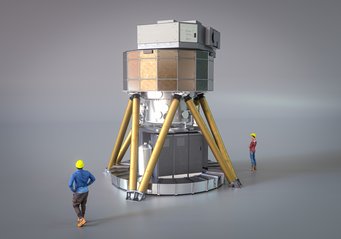Milestone reached: The MICADO instrument for the Extremely Large Telescope (ELT) has passed the Final Design Review
MICADO (Multi-AO Imaging Camera for Deep Observations), the powerful high-resolution camera for the Extremely Large Telescope (ELT) of the European Southern Observatory ESO, is one of four large scientific instruments with which the world's largest telescope for the visible and infrared wavelength range, which is currently under construction, will begin its scientific operations in Chile before the end of this decade. The instrument has now passed the Final Design Review (FDR) - a major milestone also for the team of the Max Planck Institute for Astronomy (MPIA Heidelberg) involved in the construction of the high-tech instrument.

As with all modern telescopes, the light of the celestial objects collected by the 39m primary mirror of the ELT must be processed in the focus with high-tech measuring instruments such as special digital cameras and spectrographs. MICADO will allow the ELT to record direct images and long-slit spectra in the wavelength range between 0.8 and 2.4 micrometers in unprecedented quality. This will significantly advance almost all areas of modern astronomical research. Thanks to Adaptive Optics (AO), with which the image blurring caused by turbulence in the Earth's atmosphere can be corrected in real time, the image quality of MICADO will be diffraction-limited and will even be able to exceed the resolution of the James Webb Space Telescope (JWST) by a factor of up to 6.
A total of ten institutions from six countries as well as ESO itself form the international consortium for the construction of the instrument, which is led by the Max Planck Institute for Extraterrestrial Physics (MPE) in Garching. The MPIA in Heidelberg supplies the warm pre-optics (ambient temperature) of MICADO, which guides the starlight from the telescope into the cold main camera optics (nitrogen-cooled, 77K) with virtually no loss of sensitivity or image sharpness. This subsystem prepares the beam coming directly from the telescope for MICADO, so to speak. In addition, the MPIA supplies the calibration unit for all standard scientific observation modes. With contributions to MICADO and METIS, the Max Planck Institute for Astronomy in Heidelberg is involved in two of the four first-generation ELT instruments.
Today, ESO has officially announced that MICADO has passed the “Final Design Review”. The original ESO press release explains the purpose and significance of this important milestone as follows:
The purpose of this last part of the multi-stage final design review (FDR) was to provide a wrap-up of the design process that has been going on for several years. While manufacturing usually begins only after the FDR is passed, the green light for manufacturing many of its components and sub-systems was already given previously, to enable the MICADO project to continue progressing towards ELT’s first light. To complete the design review, members of the consortium worked with ESO staff to clarify the remaining open issues about the instrument design. The passing of this milestone will enable the MICADO consortium – a team of 150 people spread across six countries – to now focus fully on manufacturing and testing the instrument.
This sophisticated design will allow MICADO to obtain high-resolution images of the Universe that reveal the detailed structures and formation mechanisms of distant galaxies and allow astronomers to study individual stars and stellar systems in nearby galaxies as well as planets and planet formation outside our solar system. In addition, MICADO will act as a uniquely powerful tool for exploring environments where gravitational forces are extremely strong, such as close to the supermassive black hole at the centre of our galaxy, the Milky Way.
In a video entitled “Meet MICADO, a super-camera for the ELT!” you will find detailed information about the construction, operation and scientific goals of the remarkable ELT instrument
(see https://www.eso.org/public/unitedkingdom/videos/elt0001a/).
Further information on the exact composition of the MICADO consortium, other web pages on the instrument and important contact addresses can be found on the ESO page of the original press release.
KJ
